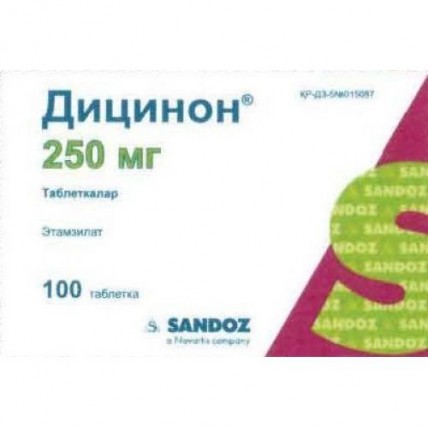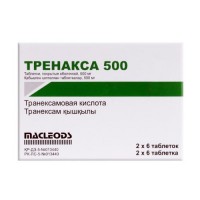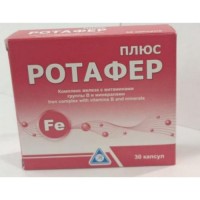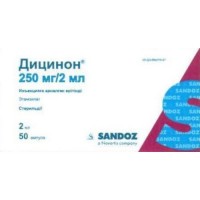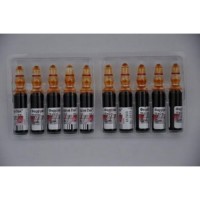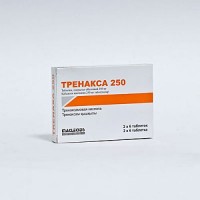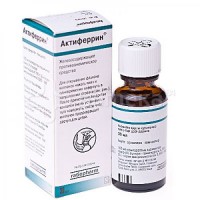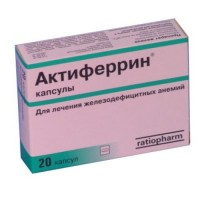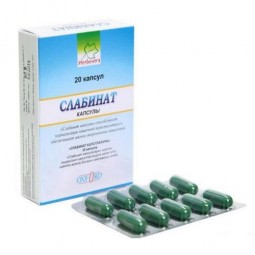The instruction for medical use
of medicine
Dicynonum
the Trade name
Dicynonum
the International unlicensed
name Etamsylate Dosage Form
of the Tablet of 250 mg
One tablet contains Structure:
active agent - etamsylate of 250 mg,
excipients: anhydrous citric acid, starch corn, lactoses monohydrate, povidone, magnesium stearate.
The description
of the Tablet of round shape, with a biconvex surface, from white till almost white color.
Pharmacotherapeutic
Vitamin K group and other haemo statics. Other system haemo statics. Etamsylate.
The ATX B02BX01 code
the Pharmacological
Pharmacokinetics Absorption Later properties of intake drug is slowly soaked up from digestive tract. After administration of drug in a dose of 500 mg the maximum kocentration in blood plasma is reached in 4 h and makes 15 mkg/ml.
Distribution
Extent of linking with proteins of blood plasma makes about 95%. Etamsylate gets through a placental barrier. Maternal and umbilical blood contain similar concentration of etamsylate. There are no data concerning etamsylate discharge with breast milk.
Removal Etamsylate is removed by kidneys in not changed look. Plasma elimination half-life of blood makes about 8 h. About 70-80% of the accepted dose are removed within the first 24 hours with urine in not changed look.
Pharmacokinetics at patients with abnormal liver functions and kidneys
Pharmacokinetic properties of etamsylate at patients with abnormal liver functions and kidneys were not studied.
The pharmacodynamics Etamsylate is the synthetic styptic and angioprotektorny drug used as primary styptic means (interaction of an endothelium thrombocytes). Improving platelet stickness and restoring capillary resistance, drug provides considerable shortening of a bleeding time and reduction of a loss of blood.
Etamsylate does not possess vasoconstrictive action, does not affect a fibrinolysis and does not change plasma coagulation factors.
Indications
- prevention and treatment of capillary bleedings of various etiology and localization: before surgeries and also on all well vaskulyarizovanny fabrics in otolaryngology, gynecology, obstetrics, urology, stomatology, ophthalmology, plastic and reconstructive surgery
- the hamaturia, a hematemesis, a melena, nasal bleeding, bleeding of gums, a metrorrhagia, primary menorrhagias, menorrhagias at the women using intrauterine contraceptives in the absence of organic pathology
the Route of administration and doses
of the Tablet accept at meal time, washing down with a small amount of water.
Use for adults and children is more senior than 14 years
During the preoperative period drug appoint one-two tablets (250,500 mg) in one hour prior to operation.
In the postoperative period drug is appointed by one-two tablets (250-500 mg) each 4-6 hours before disappearance of risk of developing bleeding.
At a hamaturia, a hematemesis, a melena, nasal bleeding, bleeding of gums: in most cases the single dose makes on 2 tablets 2-3 times a day (maximum daily dose of 1000-1500 mg).
At meno-/the metrorrhagia should appoint two tablets 3 times a day (1500 mg) within 10 days, since 5th day from the expected beginning of periods till 5th day of the following menstrual cycle.
Use for children (children are more senior than 6 years)
the Dose for children makes a half of a dose for adults, i.e. on & frac12, - 1 tablet 2-3 times a day.
Patients with abnormal liver functions and kidneys.
The clinical recommendations about dosing made relatively are not enough therefore at such patients drug should be used with care.
Side effects
By-effects are classified by frequency: very often (& ge, 1/10), it is frequent (& ge, 1/100, & lt, 1/10), infrequently (& gt, 1/1000 and & lt, 1/100), is rare (& ge, 1/10000, & lt, 1/1000), is very rare (& lt, 1/10000) and unknown frequency (which frequency cannot be determined on the basis of the available data).
Often
- nausea, diarrhea, an abdominal pain
- skin rash
- a headache
- an asthenia
Seldom
- an arthralgia
Very seldom
- fever
- a thrombembolia
- an agranulocytosis, a neutropenia, thrombocytopenia
- reactions of hypersensitivity
- a sharp porphyria
In most cases all side effects weak and passing, however, if symptoms do not pass the question of a dose decline or the termination of treatment has to be considered.
Contraindications
- hypersensitivity to active ingredient of drug to etamsylate or to any of excipients
- a sharp porphyria
- children up to 6 years
With care:
- fibrinferments, a thrombembolia in the anamnesis
- bleedings against the background of overdose of anticoagulants
- an abnormal liver function and kidneys (there is no clinical experience of use)
Medicinal interactions
of Interaction with other medicines are not known.
The special
instructions Drug it is not effective at patients with thrombocytopenia. At the hemorrhagic complications connected with overdose of anticoagulants it is recommended to use specific antidotes. Use of the drug Dicynonum for patients with the broken indicators of a coagulant system of blood is possible, but it has to be complemented with administration of the drugs eliminating the revealed deficiency or defect of factors of a coagulant system of blood.
In a hemoblastosis at children (lymphatic and myeloid leukemia, an osteosarcoma) it is necessary to use drug with extra care (as aggravation of symptoms was noted).
If Dicynonum is applied to reduction of excessive and/or long menstrual bleeding and improvement it is noted, it is necessary to exclude the possible pathological reasons.
Drug contains lactose therefore it is not necessary to appoint drug sick with rare inborn intolerance of a galactose, a lactose intolerance or a sprue of glucose galactose.
Pregnancy and the period of a lactation
Safety of use of drug at pregnancy is not established. Dicynonum should be applied at pregnancy only in individual cases if it is considered necessary when the potential advantage for mother exceeds potential risk for the child.
In need of prescribing of drug in the period of a lactation it is necessary to resolve an issue of the breastfeeding termination.
Features of influence of medicine on ability to run the vehicle or potentially dangerous mechanisms
of the Research on studying influence of drug on ability to driving by motor transport and to control of mechanisms were not carried out.
Overdose
At the moment symptoms of overdose are unknown. In case of possible overdose it is necessary to carry out symptomatic treatment.
The form of release and packing
On 10 tablets place in blister strip packaging from polyvinylchloride/polyvinylidene chloride and aluminum foil.
On the 10th planimetric packings together with the instruction for medical use in the state and Russian languages put in a cardboard pack.
Storage conditions
In the dry, protected from light place at
a temperature not higher than 25 S. Hranit out of children's reach!
Not to use a period of storage of 5 years after the expiry date specified on packing.
Prescription status
According to the prescription
the Lek of Pharmasyyutikals Producer of d, Slovenia
Verovskova 57, Ljubljana, Slovenia
the Packer Lek Pharmasyyutikals of d, Slovenia
Trimlini 2D, Lendava, Slovenia
the Owner of the registration certificate
Lek Pharmasyyutikals of.d, Slovenia
Verovskova 57, Ljubljana, Slovenia
the Address of the organization accepting in the territory of the Republic of Kazakhstan claims from consumers on quality of products (goods)
Representative office of JSC Sandoz Pharmasyyutikals of of in Republic of Kazakhstan Almaty, Luganskogo St. 96,
the Phone number - 258 10 48, fax: +7 727 258 10 47
e-mail: kzsdz.drugsafety@sandoz.com
of medicine
Dicynonum
the Trade name
Dicynonum
the International unlicensed
name Etamsylate Dosage Form
of the Tablet of 250 mg
One tablet contains Structure:
active agent - etamsylate of 250 mg,
excipients: anhydrous citric acid, starch corn, lactoses monohydrate, povidone, magnesium stearate.
The description
of the Tablet of round shape, with a biconvex surface, from white till almost white color.
Pharmacotherapeutic
Vitamin K group and other haemo statics. Other system haemo statics. Etamsylate.
The ATX B02BX01 code
the Pharmacological
Pharmacokinetics Absorption Later properties of intake drug is slowly soaked up from digestive tract. After administration of drug in a dose of 500 mg the maximum kocentration in blood plasma is reached in 4 h and makes 15 mkg/ml.
Distribution
Extent of linking with proteins of blood plasma makes about 95%. Etamsylate gets through a placental barrier. Maternal and umbilical blood contain similar concentration of etamsylate. There are no data concerning etamsylate discharge with breast milk.
Removal Etamsylate is removed by kidneys in not changed look. Plasma elimination half-life of blood makes about 8 h. About 70-80% of the accepted dose are removed within the first 24 hours with urine in not changed look.
Pharmacokinetics at patients with abnormal liver functions and kidneys
Pharmacokinetic properties of etamsylate at patients with abnormal liver functions and kidneys were not studied.
The pharmacodynamics Etamsylate is the synthetic styptic and angioprotektorny drug used as primary styptic means (interaction of an endothelium thrombocytes). Improving platelet stickness and restoring capillary resistance, drug provides considerable shortening of a bleeding time and reduction of a loss of blood.
Etamsylate does not possess vasoconstrictive action, does not affect a fibrinolysis and does not change plasma coagulation factors.
Indications
- prevention and treatment of capillary bleedings of various etiology and localization: before surgeries and also on all well vaskulyarizovanny fabrics in otolaryngology, gynecology, obstetrics, urology, stomatology, ophthalmology, plastic and reconstructive surgery
- the hamaturia, a hematemesis, a melena, nasal bleeding, bleeding of gums, a metrorrhagia, primary menorrhagias, menorrhagias at the women using intrauterine contraceptives in the absence of organic pathology
the Route of administration and doses
of the Tablet accept at meal time, washing down with a small amount of water.
Use for adults and children is more senior than 14 years
During the preoperative period drug appoint one-two tablets (250,500 mg) in one hour prior to operation.
In the postoperative period drug is appointed by one-two tablets (250-500 mg) each 4-6 hours before disappearance of risk of developing bleeding.
At a hamaturia, a hematemesis, a melena, nasal bleeding, bleeding of gums: in most cases the single dose makes on 2 tablets 2-3 times a day (maximum daily dose of 1000-1500 mg).
At meno-/the metrorrhagia should appoint two tablets 3 times a day (1500 mg) within 10 days, since 5th day from the expected beginning of periods till 5th day of the following menstrual cycle.
Use for children (children are more senior than 6 years)
the Dose for children makes a half of a dose for adults, i.e. on & frac12, - 1 tablet 2-3 times a day.
Patients with abnormal liver functions and kidneys.
The clinical recommendations about dosing made relatively are not enough therefore at such patients drug should be used with care.
Side effects
By-effects are classified by frequency: very often (& ge, 1/10), it is frequent (& ge, 1/100, & lt, 1/10), infrequently (& gt, 1/1000 and & lt, 1/100), is rare (& ge, 1/10000, & lt, 1/1000), is very rare (& lt, 1/10000) and unknown frequency (which frequency cannot be determined on the basis of the available data).
Often
- nausea, diarrhea, an abdominal pain
- skin rash
- a headache
- an asthenia
Seldom
- an arthralgia
Very seldom
- fever
- a thrombembolia
- an agranulocytosis, a neutropenia, thrombocytopenia
- reactions of hypersensitivity
- a sharp porphyria
In most cases all side effects weak and passing, however, if symptoms do not pass the question of a dose decline or the termination of treatment has to be considered.
Contraindications
- hypersensitivity to active ingredient of drug to etamsylate or to any of excipients
- a sharp porphyria
- children up to 6 years
With care:
- fibrinferments, a thrombembolia in the anamnesis
- bleedings against the background of overdose of anticoagulants
- an abnormal liver function and kidneys (there is no clinical experience of use)
Medicinal interactions
of Interaction with other medicines are not known.
The special
instructions Drug it is not effective at patients with thrombocytopenia. At the hemorrhagic complications connected with overdose of anticoagulants it is recommended to use specific antidotes. Use of the drug Dicynonum for patients with the broken indicators of a coagulant system of blood is possible, but it has to be complemented with administration of the drugs eliminating the revealed deficiency or defect of factors of a coagulant system of blood.
In a hemoblastosis at children (lymphatic and myeloid leukemia, an osteosarcoma) it is necessary to use drug with extra care (as aggravation of symptoms was noted).
If Dicynonum is applied to reduction of excessive and/or long menstrual bleeding and improvement it is noted, it is necessary to exclude the possible pathological reasons.
Drug contains lactose therefore it is not necessary to appoint drug sick with rare inborn intolerance of a galactose, a lactose intolerance or a sprue of glucose galactose.
Pregnancy and the period of a lactation
Safety of use of drug at pregnancy is not established. Dicynonum should be applied at pregnancy only in individual cases if it is considered necessary when the potential advantage for mother exceeds potential risk for the child.
In need of prescribing of drug in the period of a lactation it is necessary to resolve an issue of the breastfeeding termination.
Features of influence of medicine on ability to run the vehicle or potentially dangerous mechanisms
of the Research on studying influence of drug on ability to driving by motor transport and to control of mechanisms were not carried out.
Overdose
At the moment symptoms of overdose are unknown. In case of possible overdose it is necessary to carry out symptomatic treatment.
The form of release and packing
On 10 tablets place in blister strip packaging from polyvinylchloride/polyvinylidene chloride and aluminum foil.
On the 10th planimetric packings together with the instruction for medical use in the state and Russian languages put in a cardboard pack.
Storage conditions
In the dry, protected from light place at
a temperature not higher than 25 S. Hranit out of children's reach!
Not to use a period of storage of 5 years after the expiry date specified on packing.
Prescription status
According to the prescription
the Lek of Pharmasyyutikals Producer of d, Slovenia
Verovskova 57, Ljubljana, Slovenia
the Packer Lek Pharmasyyutikals of d, Slovenia
Trimlini 2D, Lendava, Slovenia
the Owner of the registration certificate
Lek Pharmasyyutikals of.d, Slovenia
Verovskova 57, Ljubljana, Slovenia
the Address of the organization accepting in the territory of the Republic of Kazakhstan claims from consumers on quality of products (goods)
Representative office of JSC Sandoz Pharmasyyutikals of of in Republic of Kazakhstan Almaty, Luganskogo St. 96,
the Phone number - 258 10 48, fax: +7 727 258 10 47
e-mail: kzsdz.drugsafety@sandoz.com
